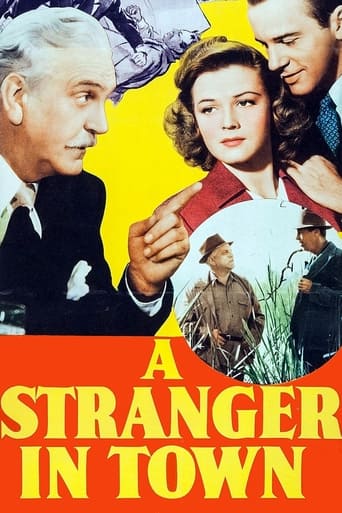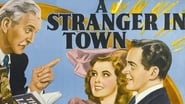LeonLouisRicci
What makes this one Stand Out from War Years Motion Picture Portrayals of Small Town America is the Realist Portrayal of Corruption. Films of that Era (WWII) Tended to Propagandize the USA as a Utopia of Goodness as its Rally Cry to Ramp Up the Citizenry.Nothing Wrong with that but it is Refreshing that this Little Movie had the Integrity to Say that Maybe We were not Perfect and some Fighting was needed Right Here at Home. Notice how the Justice Prods and Pokes at Apathy and Cowardice against Inequities and Bullying.It's all Done in a Lighthearted Manner and is Good Entertainment while Posing Questions and Inspiring to a Greater Good. Certainly Worth a Watch for 1943 Cultural References that are Still Relevant Today.
Kittyman
In "Mr. Smith Goes to Washington" (1939), fly-over wisdom solves Washington corruption. In "A Stranger in Town" (1943), Washington wisdom solves fly-over corruption.Frank Morgan portrays an incognito Supreme Court justice, who during his duck-hunting vacation, is reluctantly drawn into a small town fight against corruption. It is a dramatic change from his usual flamboyant-befuddled performance, and he does pretty well. One discordant note, however, occurs early in the picture. Morgan, while cradling a shotgun, meanders throughout town, into a barbershop, and even a courtroom. Nowadays, he'd have been pounced on, and probably branded a lunatic.The film's pace is snappy, the romantic leads (Richard Carlson and Jean Rogers) have excellent chemistry, and the supporting cast is fabulous. It includes Robert Barrat, Porter Hall, John Hodiak (in his debut), Donald MacBride, Andrew Tombes, and Chill Wills (later Francis-the-Talking-Mule's voice). Ironically, however, Robert Barrat, who does a fine job playing the oleaginous mayor, had, about a decade earlier, been cast in an opposing role as a bucolic reformer fighting corruption. (His part was in "The St. Louis Kid" [1934], a charming James Cagney vehicle.) Yet, "A Stranger" has two sloppy errors, both of which occur in the same scene. (They should have been caught and corrected.) First, Carlson enters the local hotel and orders a "single room" for the night, but walks away leaving his key behind. Then, the following morning in court, he testifies that the hotel had violated the law by having the twin beds in his room placed less than two feet apart. If his room was a single, however, it wouldn't have had twin beds.Finally, you might try following-up this film with "The Magnificent Yankee" (1950) if you're into related double features. It is a heartwarming story about Oliver Wendell Holmes, an actual Supreme Court justice, whose tenure would have ended at about the same time Morgan's fictitious one had started.
mrb1980
Frank Morgan discards his "confused middle-aged guy" persona to star in this moralistic, yet fine early 1940s film. Morgan plays the role of John Josephus Grant, an associate justice of the U.S. Supreme Court. Grant is overworked, and takes a hunting trip to Crownport, a typical small town. Here he quickly becomes embroiled in corrupt local politics, headed by a very crooked and despicable local judge (Porter Hall). He teams up with his secretary (Jean Rogers) and a local mayoral candidate (Richard Carlson) to overcome the bad guys and clean up the town. Of course, there's an obligatory love story, involving the characters of Rogers and Carlson.Morgan takes full advantage of this rare top-billed role and gives a warm and believable performance. Rogers is also in top form, while Carlson is just average in an average role. Morgan's rousing speech to the local townsfolk about American government may seem a little overripe today, but is perfect in the context of a WWII-era movie. It's also fun to watch the town's corrupt bosses squirm when they find out Morgan's true identity. This film's a reflection of a long-ago time when people generally trusted our political institutions.
Sgt. Schultz
"A Stranger in Town" turns out to be a pleasant surprise. I originally viewed it to see Frank (The Wizard of Oz) Morgan in a starring role, and did not have any grand expectations. But it turned out to be a droll little film, quite entertaining.The whole plot is predicated on the general anonymity of Supreme Court justices. Does anyone know what they look like? Can anyone even name all 9? Along the way, we get a look and some commentary on small town American life in the 1940s, as well as a Capra-esque speech by Morgan near the end of the film.Their is also some requisite romantic interest thrown in, which is quite incidental and was probably just added to stretch out the running time. The film also has Porter Hall, who played the heel in "Miracle on 34th St." and the heel in "The Thin Man", playing, you guessed it, a heel.Overall, a very pleasant way to spend 70 minutes. Give it a view when you get the chance.




